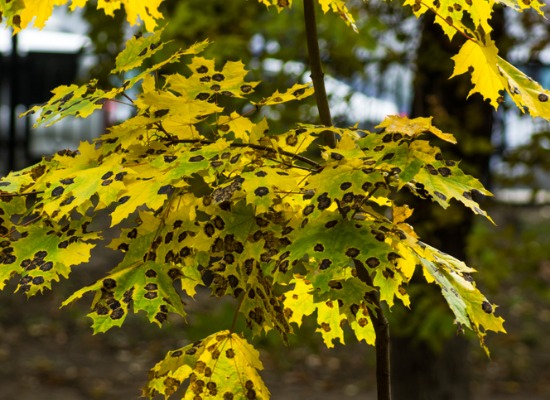TREE EDUCATION

Maintaining the health of your trees is an important aspect of keeping your landscape beautiful. Unfortunately, as with all living things, trees are susceptible to certain types of disease and require care to avoid illness. Sick trees are not only aesthetically unpleasing, but they become structurally unsound, posing a hazard both to your property and the individuals within it. When a tree is diseased, the actions you should take depend on the type of tree, the tree risk, and the type and stage of the disease it has. When caught and treated early on, some diseased trees can make a full recovery. However, in other situations, the optimal solution may be to contact master arborists for tree pruning and even tree removal.
Learn about five of the most common tree diseases in Florida that can make your tree sick and the symptoms of each. Contact SkyFrog Tree Service today to request a free estimate for our local, insured tree services.
Ganoderma is a large and diverse type of wood-decaying fungi that causes root damage and damage to the lower trunk of many different tree species. Several Ganoderma species are found within the southeastern United States, producing shiny, reddish-brown fruiting bodies with shelf-like structures. Ganoderma's fruiting bodies display a pale, porous surface on the bottom that darkens with time or handling and it may or may not have a stem. When these fruiting bodies are seen, it's a sign that wood decay is present and active, whether it is seen on fallen logs, buried tree roots, or on the trunks of living or dead trees. Some common signs of this tree disease are leaves that begin to wilt and turn yellow, trees that lose their luster and vitality as the sapwood decays, and the presence of fruiting bodies (or conks) on the lower trunk area. If you notice any of these signs in your trees, contact us to discuss possible tree restoration and preservation solutions with our certified arborists.
Oak trees are some of the most beloved types of trees in central and northeast Florida. As part of Florida's natural and urban forests, oak trees are highly prized for their aesthetic, economical, and ecological value. Unfortunately, however, oaks in the region have become particularly susceptible to several different health issues, sometimes caused by pathogens and otherwise often caused by human activity. As one of the most common causes of oak mortality, oak wilt is a vascular disease caused by a fungus that spreads from infected trees to nearby healthy trees. It is primarily transmitted through root grafts, and it causes sudden wilting, early leaf drop, leaf discoloration, and even vascular streaking in the sapwood. Because oak wilt can resemble many other tree issues, seeking professional confirmation from a licensed arborist is crucial to treat this disease, particularly with mature tree care.
Apple scab is a common tree disease caused by Venturia inaequalis, a harmful ascomycete fungus. This fungal disease causes the direct loss of fruit, defoliation (loss of leaves), and attacks both leaves and fruit of apple trees, ornamental crabapple trees, and other types of fruit trees. The disease forms pale, yellow, or olive-green colored spots on the upper surface of leaves as well as dark, velvety spots on the leaves' lower surface. Leaves severely infected with the disease can become twisted and puckered. Symptoms of the fruit are similar to those found on the leaves. Scabby fruit spots are sunken and tan, and they may feature velvety spores at their center. With time, these spots can grow and turn brown and appear cork-like. Infected fruit often becomes distorted and can crack, producing entry points for other organisms. Fruit that is severely affected may drop prematurely. This disease favors wet weather in the spring and early summer. Fungal spores can be carried by wind, splashing groundwater on flowers, leaves, fruit, or rain. The longer the leaves are wet, the more severe the infection.
Laurel wilt is a deadly fungal disease that primarily affects redbay, swamp bay, and avocado trees, among other trees within the laurel family. Laurel wilt is caused by Raffaelea lauricola, first introduced by nonnative redbay ambrosia beetles. The most common symptoms associated with laurel wilt include wilted green leaves in the tree's canopy that quickly brown, dark streaks underneath the bark with a blue-black color, and tiny holes with sawdust tubes that begin to appear on the tree's trunk and limbs as the disease progresses. Laurel wilt spreads rapidly to trees throughout the State of Florida and can be difficult to treat if not caught and remedied early on in the disease's lifecycle. In most cases, the best way to treat laurel wilt is to remove the infected tree to slow down the spread of the disease to other nearby trees. Once removed, the tree should be burned or chipped, including the stump. The use of insecticides and fungicides have not proven to be effective when treating laurel wilt.
Fusiform rust is among the most destructive tree diseases affecting pines in the southern region of the United States. This stem disease is caused by a fungus known as Cronartium quercuum. Pine trees that are native to Florida are particularly susceptible to fusiform rust. The splash pine and loblolly pine typically sustain the most severe damage from this disease. Some common symptoms of fusiform rust include cigar-shaped galls that appear on the central tree stem, yellow-orange blisters that form on the galls with time, and rust-colored spores present when the infected trunk or branches break open. Trees with fusiform rust may pose a significant safety hazard due to stem breakage, and, as such, tree removal is often the best option in urban areas. In other areas, a preferred form of tree disease treatment may involve removing the bark from the infected tree stem and removing other diseased parts of the tree.